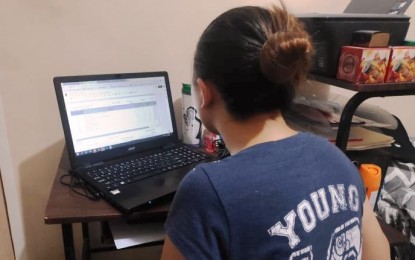
EDUCATIONAL TOOL. Senior high school teacher Roanne Davila says she is aware that data privacy, misinformation, and fake news are among the concerns over the use of Facebook in education but at the same time notes that the pros outweigh the cons especially for students belonging to poor communities. The coronavirus pandemic has prompted many schools to explore different educational tools for the blended and distance learning. (Contributed photo)
MANILA – The time has come for teachers and students to utilize Facebook and other free learning platforms for education, Mark Madrona, a senior high school teacher at Batasan Hills National High School in Quezon City, said.
Since the coronavirus disease 2019 (Covid-19) pandemic is forcing teachers to embrace blended and distance learning strategies to ensure that knowledge sharing continues, Madrona said he is considering to use Facebook because students and teachers are already familiar with it.
Canvas, Google Classroom, and Quipper School are already being tapped as learning platforms, but according to Madrona, teachers and students who are not particularly tech savvy still have to figure out how to navigate them quickly.
Facebook, he said, makes it easy to share learning resources such as attachments, articles, and even links to videos that students may find helpful.
“Ituturo pa sa bata (We would still have to teach kids) how the platform works so why don’t we check out platforms already known to students. Nasa Facebook naman ang lahat ng tao (Almost everyone is on Facebook),” he said over a phone interview with PNA.
Roanne Davila, senior high school teacher in San Nicolas, Bacoor City, prefers Google Classroom as it allows her to check on whether or not students have completed their work.
She, however, admitted that she also uses Facebook when internet connection is unreliable. Telecommunication companies like Smart and Globe also already provide free access by registering to select promos.
“Google Classroom seems the best kasi (because) it’s easier for the teacher to monitor the tasks. But if a student can’t get access (to other platforms), we use Facebook,” she said in an interview.
Davila is aware that data privacy, misinformation, and fake news are among the concerns over the use of Facebook as educational tool but at the same time notes that the pros outweigh the cons especially for students belonging to poor communities.
On the other hand, Madrona, who teaches English, thinks of these issues as opportunities to further develop media literacy when it comes to consuming information and producing and sharing content.

Learning options
Despite the advantages of online learning environment, a survey conducted by the Department of Education (DepEd) showed that parents preferred the modular learning system over other options available for the upcoming school year.
Teacher are getting ready for the transition to blended/ distance learning which combines printed and offline digital modules, online, and TV and radio-based instruction while keeping in mind that each student would have different preferences.
Davila said that in their school, printed modules will be available to all students regardless of what option they choose.
“Students who choose online or modular will be (assigned) under the teacher who chose the same modality. But for now, every student is given a printed module. So even if a student chooses online, he still gets a module in case internet connection isn’t available,” she said.
Currently, Davila said she has to physically report for work twice a week but this policy differs depending on whether there is a higher risk of Covid-19 infection.
Printed modules are also being eyed in the school where Madrona teaches but he said it is not yet certain who will be tasked to distribute these modules.
He admitted that some faculty members would not have a choice but to “go the extra mile” to help in the distribution of modules and other printed materials.
The DepEd earlier said it will seek the help of local government units in distributing modules for students.
Tech woes
It is no secret that the lack of gadgets and unstable internet connection are among the problems raised in relation to adopting blended/distance learning.
Madrona is hopeful that plans to provide teachers with “internet allowance” will be realized.
“May nababanggit daw na magpo-provide (There are talks that the school is going to provide the allowance) but it’s still in the drawing board,” he said.
Currently, he relies on his trusty laptop to get the hang of blended/distance learning strategies in the weeks leading up to the opening of classes.
While shifting to blended/distance learning strategies would require a huge change for some educators, others have the advantage of having incorporated these approaches even before the pandemic.
Aurora Bautista, a professorial lecturer connected with the University of the Philippines Open University in Los Baños, Laguna provides tutorial, mentoring, and training services to teachers.
While all her students have laptops or computers, she said they still complain about poor connectivity which is often the reason for late submission of requirements.
“You have to be lenient. You cannot blame students for the bad internet services,” she said in an interview over Facebook Messenger.
Given these challenges, Bautista stressed the importance of teachers providing necessary resources to students in a blended/distance learning setup.
“The focus of blended learning is to help or facilitate the learning of the student and for the students to be responsible for their own learning,” she said.
She noted that it is also key to provide massive teacher training in designing learning activities which will in turn encourage students to be responsible for their own learning.
“What is equally important is the provision of learning materials in print. It is very important in the K-12 students to have materials on hand to read. Not everything they need can be accessed online and even if internet services are reliable, there are many issues obtaining from computer use,” she said. (PNA)
